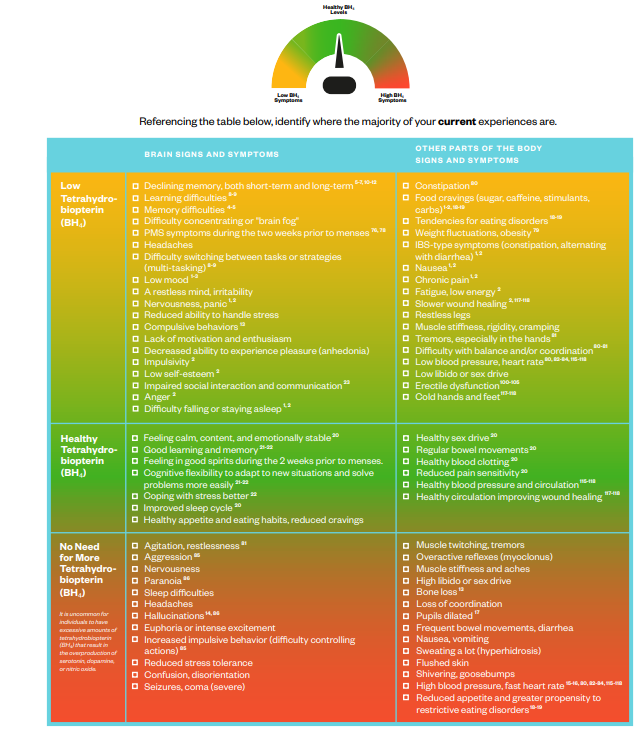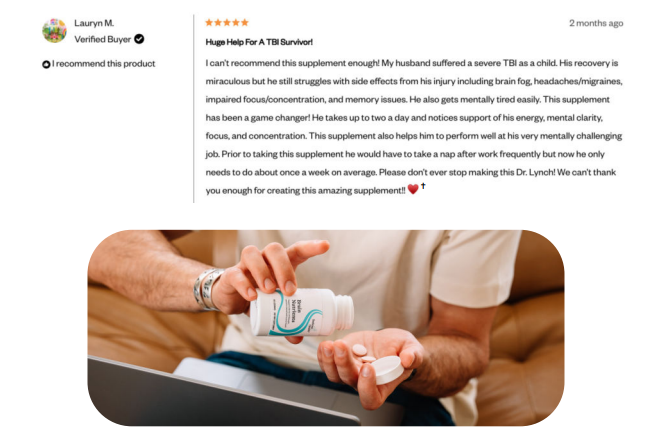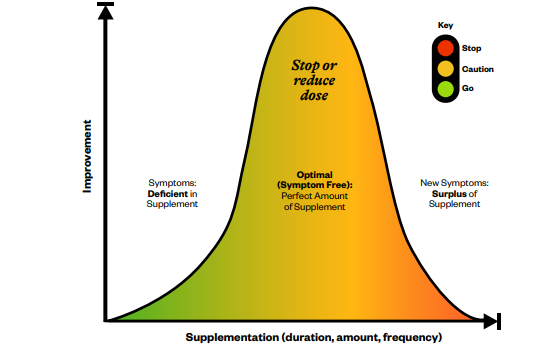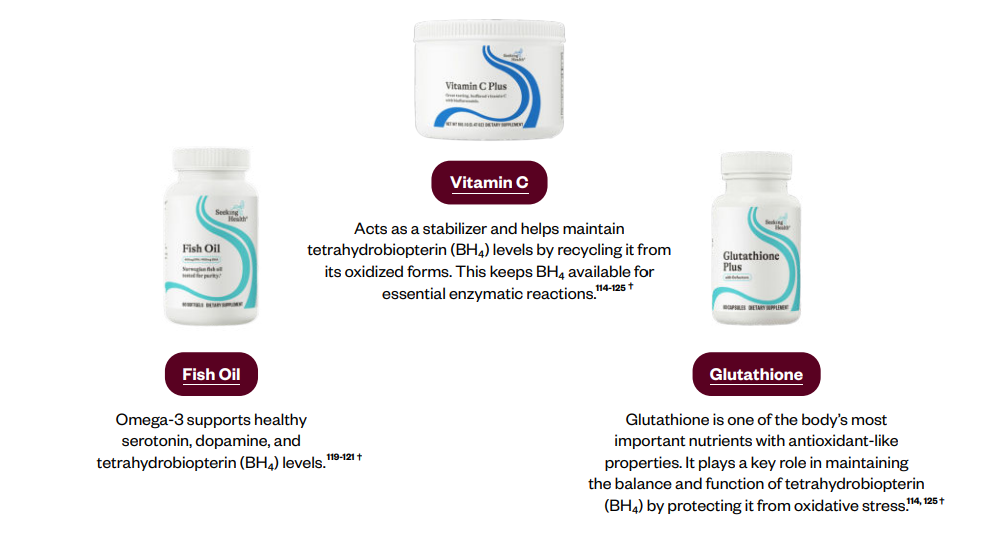How to use Brain NutrientsUpdated a month ago

Having a foggy brain is frustrating.
Can’t think, low mood, poor memory, and just a heavy, dull feeling in your head—an all-too-common occurrence.
Why?
Your Brain Is Always “On”
We often forget how much our brain does behind the scenes. Even when you’re at rest, it’s juggling dozens of tasks—all at once. It helps you move, sense, digest, breathe, and regulate your heartbeat. Beyond that, it processes every thought, emotion, interaction, and decision. It’s like a high-powered engine running 24/7—but that also means it needs proper fuel and maintenance.
The challenge? Your brain is incredibly sensitive. When just one key compound is off, everything—from your mood to your memory—can be affected.
 Meet BH₄
Meet BH₄
Most people have heard of dopamine and serotonin—the “feel-good” chemicals that support things like focus, motivation, sleep, and mood. Nitric oxide is another crucial one, playing a big role in blood flow and circulation. But what isn’t as widely known is how these substances are made—and the key compound behind their creation.
That compound is tetrahydrobiopterin, often shortened to biopterin and even shorter as BH4. BH4 is essential for your brain to produce neurotransmitters like dopamine and serotonin, and it also helps generate nitric oxide.
Without enough BH4, your brain struggles to function properly. You might feel constantly tired, irritable, unfocused, and emotionally overwhelmed. Even your body might signal trouble—through headaches, poor sleep, or reduced stamina and circulation.
Why BH₄ Gets Depleted
Your body’s supply of BH4 is surprisingly fragile. Several common, everyday factors can reduce its levels significantly:
- Chronic stress
- Nutrient deficiencies (folate, B12, zinc)
- Inflammation
- Infections
- Folic acid
- Chemicals such as chlorine, formaldehyde
- Excessive exercise
How Are Your Tetrahydrobiopterin (BH₄) Levels?
Check!
Low levels of tetrahydrobiopterin (BH4) can lead to symptoms related to:
- Low serotonin
- Low dopamine (DA), which can also lead to low norepinephrine (NE)
- Low nitric oxide (NO)
Because BH4 plays a key role in producing these compounds, it makes sense that symptoms of low, balanced, or high BH4 levels will reflect similar patterns in serotonin, dopamine, norepinephrine, and nitric oxide.

How to Use Brain Nutrients
The first time you use Brain Nutrients is the most powerful. Thus, start low. Start with ¼ lozenge, place it in your mouth, let it dissolve slowly, then swallow when it’s gone.
Often, people begin to feel the effects within a very short amount of time. The feelings are frequently a clear head, a happy mood, noticing bright colors, and energy.†
Use Brain Nutrients to support healthy levels of tetrahydrobiopterin (BH4), which ultimately supports healthy levels of serotonin, dopamine, and nitric oxide.†
This means you should take Brain Nutrients only as needed, not necessarily every day.†
Typical Suggested Usage Schedule:
Most people do well with a simplified dosing schedule using Brain Nutrients lozenges.
These are examples of various common usage schedules people use successfully:
- Take ¼ to 1 lozenge upon waking first thing in the morning instead of reaching for caffeine or sugar.
- Tune in to how your head is feeling: minor brain fog consider ¼ lozenge and if significant, consider 1 full lozenge as it supports healthy brain function.†
- Have a bottle at your desk at work, or in your backpack at school. Take ¼ to 1 lozenge as needed if you need more support in brain function.
- Let the lozenge dissolve entirely before swallowing.
- Stack ½ to 1 lozenge of Brain Nutrients with a capsule of either Dopamine Nutrients or Serotonin Nutrients.
- Do not take it within 5 hours of bedtime.
The duration of effect from Brain Nutrients varies from individual to individual.

How to Use Brain Nutrients Generally
The Pulse Method is Dr. Lynch’s method for starting, pausing, or stopping a supplement based on how you’re feeling. Implement this method after consulting with your healthcare practitioner and introducting a new supplement into your diet and after consulting wih yout doctor. The Pulse Method has helped people reduce side effects, support healthy outcomes, and save money.

What Does It Mean To Supplement?
The word supplement literally means “to add to or enhance.” Supplementation is used to “top off” nutrients you should already receive daily from eating, though sometimes you may not. It is also a tool to aid the body in supporting nutritional balance, which can be offset due to poor food quality and a lack of essential vitamins and minerals.
Real-Life Usage Scenarios:
1. A 78-year-old grandfather had some difficulty with memory. He would lose his train of thought and often struggle to find words. He started taking Brain Nutrients, and he and his wife noticed significant support in a short space of time. His neurotransmitter levels (when tested) showed very low dopamine and high tyrosine levels. This indicated that he had enough of the amino acid tyrosine to make dopamine, but not enough cofactor to make this reaction happen. Brain Nutrients provides cofactor support in producing dopamine, which explains why he felt significant support from this supplement.†
2. Dr. Lynch uses this supplement nearly every morning when waking up to start his day. He uses either ½ to 1 lozenge, depending on how much support he feels he needs.
3. Prior to exercise, Dr. Lynch and his college-age sons take 1 full lozenge just before exercising, like taking a hike, playing sports, or lifting weights in the gym. They’ve noticed healthy energy, performance, and exercise is just more enjoyable.†
4. A 50-year-old male with healthy testosterone levels took Dopamine Nutrients and said he felt nothing. Dr. Lynch advised him to add 1 lozenge of Brain Nutrients in addition to taking Dopamine Nutrients, as he suspected he was lacking the biopterin cofactor. The next day, the gentleman reported he now felt the dopamine effects significantly when he took these two supplements together, illustrating the importance of biopterin.†
5. An individual reported taking Brain Nutrients after their night of indulging in a lot of alcohol. They noticed a healthy recovery supported.†
How to Further Optimize Your Tetrahydrobiopterin (BH₄)
Eat foods rich in methylfolate, niacin, and magnesium. Folate protects and regenerates BH4. Niacin and magnesium are needed for producing BH4. Food high in these nutrients includes:
- Leafy green vegetables
- Asparagus
- Lentils
- Sprouted legumes (think Ezekiel bread)
- Animal protein
- Nuts and seeds
Eat foods high in antioxidant properties. Antioxidant properties, like the ones in vitamin C, help recycle and stabilize BH4, protecting it from oxidative breakdown. Foods high in antioxidant properties include:
- Berries
- Colorful fruits and vegetables
- Dark chocolate
Eat nitrate-rich foods. Nitrate supports nitric oxide production and supports healthy BH4 production. Foods high in nitrates include:
- Beets
- Leafy greens
- Pomegranate

Maintain adequate protein intake. Amino acids derived from protein work alongside BH4 to produce serotonin, dopamine, and nitric oxide. This brings us to the next point:
- Support healthy stomach acid production. Stomach acid (HCl) is needed to break down dietary protein into absorbable amino acids. Eat bitter foods with meals or sip water containing lemon juice or apple cider vinegar before meals. Make sure you eat in a relaxed, non-stressful environment, such as the park across from the office, rather than in the office.
Exercise regularly. Regular aerobic exercise helps maintain or increase BH4 levels in the blood vessels, supporting healthy nitric oxide (NO) production and circulation.111-112
Address any triggers of inflammation or oxidative stress. Oxidative stress oxidizes BH4, making it unusable unless recycled. Factors that can increase oxidative stress include:
- Unresolved gut dysbiosis: Test for and address any ongoing gut microbial imbalances that could be contributing to inflammation and oxidative stress.
- Environmental chemical exposure: Reduce exposure to environmental chemicals where possible.
Avoid folic acid in supplements and processed foods. Folic acid inhibits the DHFR enzyme, which is responsible for the recycling of biopterin.135
- Use more active forms of folate, such as folinic acid (which is found in Brain Nutrients). Folinic acid supports the production of GTP, which directly forms biopterin.†
Life Events Associated with Low Biopterin
Mood Disorders and Tetrahydrobiopterin (BH₄): Low Mood and Nervousness 23, 26
Tetrahydrobiopterin (BH4) is required to produce serotonin, dopamine, and norepinephrine. These neurotransmitters are vital for mood stability, motivation, pleasure, and emotional resistance.
When BH4 is low or its metabolism is altered, there is a decreased production of these neurotransmitters, which is strongly associated with both low mood and nervousness.
Published research and clinical observations indicate that altered BH4 status is observed in some individuals with certain mood-related conditions.92, 93 Animal studies have also shown that congenital BH4 deficiency (deficient since birth) leads to changes in behavior relevant to mood and the ability to cope with stress.94
Sleep Disorders and Tetrahydrobiopterin (BH₄) 24-28, 95-98
Tetrahydrobiopterin (BH4) is needed to produce serotonin. Melatonin, the “sleep hormone,” is produced from serotonin by the pineal gland. Any reduction in BH4 can lower serotonin levels and subsequently reduce melatonin production, contributing to sleep disturbances.
The reduction in dopamine and nitric oxide levels due to low BH4 can also contribute to sleep disorders since these compounds play essential roles in sleep-wake cycles and signalling
Learning Difficulties, Memory and Tetrahydrobiopterin (BH₄)29-38, 49-50
Serotonin, dopamine, and norepinephrine (NE) play important roles in brain areas such as the hippocampus and prefrontal cortex—regions essential for forming memories, attention, and decision-making.
- Dopamine is involved in working memory, motivation, and reinforcement of learning.
- Norepinephrine supports alertness and the encoding of memories.
- Serotonin influences emotional memory and mood.
Low levels of these neurotransmitters are seen in individuals with mild cognitive impairment or early dementia, with poorer memory and greater loss of brain tissue.
Tetrahydrobiopterin (BH4) also supports the production of nitric oxide (NO). NO produced in the blood vessels by eNOS (endothelial Nitric Oxide Synthase) helps blood vessels dilate, which allows for better blood flow in the body, including the brain. Good blood flow is vital for delivering oxygen and nutrients to brain cells during learning and memory recall.
NO produced in the brain by nNOS (neuronal Nitric Oxide Synthase) acts as a signaling molecule or neurotransmitter in the brain involved in synaptic plasticity.99 This is a process in the brain that allows the connections between neurons to strengthen or weaken over time—a foundation for learning and memory.It is especially important for a process called long-term potentiation (LTP), which is the cellular mechanism underlying memory formation. LTP is involved in making connections between neurons stronger with frequent activity. The more you repeat information while studying, the better you remember and recall it.
Behavioral and Developmental Disorders and Tetrahydrobiopterin (BH₄): Aggression, Impulsivity, Attention, and Social Communication 126-134
Tetrahydrobiopterin (BH4) is vital for serotonin, dopamine, and norepinephrine production. Serotonin and dopamine are both crucial for impulse control, emotional regulation, and social behavior. Imbalances in these neurotransmitters are often linked to conditions associated with aggression or oppositionality. 126-128
Imbalances in dopamine and norepinephrine, on the other hand, are associated with attention problems, hyperactivity, and emotional dysregulation—core symptoms of ADHD.126, 128-130
All three neurotransmitters (serotonin, dopamine, and norepinephrine) are essential for social communication, cognitive, and behavioral flexibility. These are areas in which individuals with ASD often struggle. Several open-label and controlled trials suggest that improving BH4 levels can improve ASD symptoms, including social awareness, language, hyperactivity, and repetitive behaviors in a subset of children. 131-134
Ongoing Inflammation and Tetrahydrobiopterin (BH₄): Amplification of Low BH₄ Symptoms
Tetrahydrobiopterin (BH4) is very sensitive to ongoing inflammation and oxidative stress. When this happens, BH4 is converted into dihydrobiopterin (BH2) and then fully to biopterin, the completely oxidized form. Neither BH2 (partially oxidized) nor biopterin (fully oxidized) can be used in enzyme reactions to make serotonin, dopamine, or nitric oxide.87-89
Partially oxidized BH2 can, however, be recycled back into useable BH4 by your DHFR enzyme. Fully oxidized biopterin cannot be recycled and is excreted. 90-91
Long-term inflammation or oxidative stress is typically due to traumatic brain injuries, concussions, unresolved infections (bacteria, parasites, viruses), environmental chemicals, or heavy metal exposure. This is why environmental triggers can contribute to symptoms of low BH4, such as mood and sleep disorders.
Sexual Dysfunction in Males and Tetrahydrobiopterin (BH₄): Erectile Dysfunction and Low Libido100-103
Tetrahydrobiopterin (BH4) is a critical cofactor for eNOS (endothelial Nitric Oxide Synthase) enzyme activity. eNOS uses BH4 to produce nitric oxide (NO) that supports blood vessel dilation and blood flow. This includes the blood flow necessary for penile erection.
Studies have shown that men with erectile dysfunction have markers of oxidative stress that were higher when compared to men who didn’t have erectile dysfunction, and penile tissue contained less functional (active) BH4.
Tetrahydrobiopterin (BH4) is also needed for dopamine production. Low dopamine can lead to diminished sex drive, reduced arousal, difficulty achieving or maintaining erections, and decreased motivation for sexual activity.104-105
 Exercise and Tetrahydrobiopterin (BH₄)
Exercise and Tetrahydrobiopterin (BH₄)
Exercise increases the demand for nitric oxide (NO) for blood vessel dilation to deliver more blood, oxygen, and nutrients to working muscles. By supporting eNOS (endothelial Nitric Oxide Synthase), BH4 can support healthy circulation during exercise.
Regular aerobic exercise also helps maintain or increase BH4 levels in the blood vessels, possibly slowing age-related declines in blood vessel and heart health. 111-112
When BH4 levels are optimal, eNOS is “coupled” and produces NO efficiently, supporting healthy circulation.
When BH4 levels are low, eNOS becomes “uncoupled”. Instead of making NO, it generates harmful free radicals like superoxide (SO). This reduces NO bioavailability, impairs blood vessel function, and can lead to oxidative stress and inflammation. 108-110 Ongoing inflammation results in the amplification of low BH4 symptoms, which can affect all bodily functions reliant on BH4, such as mood regulation, learning, and memory.
Histamine and Tetrahydrobiopterin (BH₄) 106-107
Nitric Oxide (NO) produced by tetrahydrobiopterin (BH4) acts as a mast cell stabilizer. Mast cells are storage cells for histamine, which is released when needed. If BH4 levels are low and NO levels are low, oxidative stress can increase within mast cells. This makes them more likely to degranulate and release histamine, contributing to high histamine symptoms.
Interactions with Medications
Do NOT use Brain Nutrients if using these medications.
Here are some common medications that may contraindicate the use of Brain Nutrients or where there needs to be caution. This list is not exhaustive. Talk with your healthcare professional to ensure there are no interactions.
| C L AS S O F D R U G | C O M M O N N A M ES | SEVERITY OF INTERACTION |
| Levodopa/dopaminergics 113 | Phenelzine (Nardil), Tranylcypromine (Parnate), Moclobemide | Monitor, adjust as needed |
| PDE5 inhibitors 113-114 | Sildenafil, Tadalafil | Use with caution |
| Nitric oxide (NO) donors 113-114 | Nitroglycerin, Sodium nitroprusside, Molsidomine, Isosorbide dinitrate, Minoxidil | Use with caution |
| DHFR inhibitors (antifolates) 113-114 | Methotrexate, Trimethoprim | Monitor, consider alternatives |
Caution: Blood pressure medications
It’s not contraindicated to use Brain Nutrients if on blood pressure medications. However, it is crucial to know of possible interactions. Monitor your blood pressure, and always consult with your healthcare professional about product interactions. Increased production of nitric oxide (NO) may lower blood pressure, which may require medication adjustments. Lowering blood pressure too much may lead to dizziness and unexpected falls.

Supportive Supplements for Brain Nutrients
 FAQs
FAQs
Do I take this every day?
Use Brain Nutrients on an as-needed basis. When you are at school or work and your brain feels like it needs some support, take ½ to 1 lozenge as needed.†
Read the symptoms of low biopterin and see if they match your current situation. If so, then take some.
Can I have too much BH₄?
Yes, despite research stating that neurotransmitter production is tightly regulated. Users of Brain Nutrients have reported side effects of headaches from taking too much or too often. It’s best to start low and wait to see how you respond before taking more. Wait at least 15 minutes before taking more.
Why would I need Brain Nutrients as opposed to Serotonin Nutrients or Dopamine Nutrients?
- If you want support for predominantly low dopamine, then take Dopamine Nutrients. If you feel nothing from taking the Dopamine Nutrients, then add in ½ a lozenge of Brain Nutrients to further support the production of dopamine.†
- If you want support for predominantly low serotonin, then Serotonin Nutrients may be more appropriate for you. If you feel nothing from taking the Serotonin Nutrients, then add in ½ a lozenge of Brain Nutrients to support the production of serotonin further.†
- If you want support for both low serotonin and dopamine, and you also have symptoms related to low nitric oxide and poor circulation, then you need more BH4 support. Brain Nutrients would be most suitable to start with. After starting Brain Nutrients, see what still needs support and then possibly stack in a Dopamine Nutrients or Serotonin Nutrients.†
Can I take Brain Nutrients while pregnant?
Yes. However, speak to your healthcare professional first
Can I take Brain Nutrients while breastfeeding?
Yes!
- Brain Nutrients provides the cofactor for making serotonin and dopamine. Serotonin Nutrients and Dopamine Nutrients provide additional support in producing serotonin and dopamine. They complement each other.†
- Be sure to check the Guides for Serotonin Nutrients and Dopamine Nutrients first if you are taking any medications. Some medications contradict the use of these two supplements.
- While BH4 is not a cofactor for acetylcholine production, it can still be taken with Optimal Focus.†
- Brain Nutrients enhances the effectiveness of Optimal Focus, Serotonin Nutrients, and Dopamine Nutrients.†
Brain Nutrients contains royal jelly concentrate, and I’m allergic to bees. Can I still take it?
No.
You should not take products containing royal jelly if you are allergic to bees, bee stings, honey, pollen, or any other bee products.
Royal jelly is a secretion from honeybees that can cause allergic reactions in some people sensitive to bee proteins or related allergens.
- Folinic acid
- PQQ
- Glutathione
I’m taking Brain Nutrients because my symptoms suggest I need it. But I don’t notice any benefits.
Brain Nutrients provides a cofactor for making dopamine, serotonin, and nitric oxide. However, you may be missing other cofactors (iron, vitamin B6) or substrates (amino acids) to complete the process.†
To bake a cake, you need all the ingredients.
You may need to add in Dopamine Nutrients or Serotonin Nutrients.†
References
1. https://www.medicalnewstoday.com/articles/serotonin-deficiency
2. https://www.healthline.com/health/serotonin-deficiency
3. https://www.healthdirect.gov.au/serotonin
4. https://pmc.ncbi.nlm.nih.gov/articles/PMC5399229/
5. https://pmc.ncbi.nlm.nih.gov/articles/PMC5017596/
6. https://pubmed.ncbi.nlm.nih.gov/17481676/
7. https://pubmed.ncbi.nlm.nih.gov/23535352/
8. https://www.medicalnewstoday.com/articles/322263
9. https://www.psych.ox.ac.uk/news/serotonin-booster-leads-to-increased-functional-brain-connectivity
10. https://neurodegenerationresearch.eu/2017/10/lower-brain-serotonin-levels-linked-to-dementia/
11. https://www.hopkinsmedicine.org/news/newsroom/news-releases/2023/12/study-suggests-serotonin-lo ss-may-contribute-to-cognitive-decline-in-the-early-stages-of-alzheimers-disease
12. https://pubmed.ncbi.nlm.nih.gov/37718818/
13. https://faseb.onlinelibrary.wiley.com/doi/epdf/10.1096/%.13-246546
14. https://pmc.ncbi.nlm.nih.gov/articles/PMC2996210/
15. https://pmc.ncbi.nlm.nih.gov/articles/PMC6413434/
16. https://pubmed.ncbi.nlm.nih.gov/22407614/
17. https://pmc.ncbi.nlm.nih.gov/articles/PMC5854659/
18. https://pmc.ncbi.nlm.nih.gov/articles/PMC305267/
19. https://pubmed.ncbi.nlm.nih.gov/1752859/
20. https://www.healthdirect.gov.au/serotonin
21. https://en.wikipedia.org/wiki/Serotonin
22. https://pmc.ncbi.nlm.nih.gov/articles/PMC5606297/
23. https://medlineplus.gov/ency/article/007272.htm
24. https://www.mayoclinic.org/diseases-conditions/serotonin-syndrome/symptoms-causes/syc-20354758
25. https://en.wikipedia.org/wiki/Serotonin_syndrome
26. https://pubmed.ncbi.nlm.nih.gov/17984558/
27. https://pmc.ncbi.nlm.nih.gov/articles/PMC7520887/
28. https://pubmed.ncbi.nlm.nih.gov/21459634/
29. https://pubmed.ncbi.nlm.nih.gov/10821328/
30. https://pmc.ncbi.nlm.nih.gov/articles/PMC5017596/
31. https://neurodegenerationresearch.eu/2017/10/lower-brain-serotonin-levels-linked-to-dementia/
32. https://pmc.ncbi.nlm.nih.gov/articles/PMC6594906/
33. https://www.psychiatrictimes.com/view/mild-cognitive-impairment-and-serotonin-system-degeneration
34. https://pmc.ncbi.nlm.nih.gov/articles/PMC11654273/
35. https://pubmed.ncbi.nlm.nih.gov/10821328/
36. https://www.frontiersin.org/journals/pharmacology/articles/10.3389/fphar.2015.00143/full
37. https://pmc.ncbi.nlm.nih.gov/articles/PMC5017596/
38. https://pmc.ncbi.nlm.nih.gov/articles/PMC3371373/
39. https://pmc.ncbi.nlm.nih.gov/articles/PMC2612120/
40. https://www.tutor2u.net/psychology/reference/aggression-neurotransmitter-serotonin
41. https://www.cam.ac.uk/research/news/serotonin-levels-affect-the-brains-response-to-anger 42. https://www.nature.com/articles/npp2013351
43. https://bbrfoundation.org/content/impulsivity-and-aggression-affected-differently-serotonin-receptor
44. https://www.frontiersin.org/journals/neuroscience/articles/10.3389/fnins.2022.919890/full
45. https://pmc.ncbi.nlm.nih.gov/articles/PMC4824539/
46. https://pmc.ncbi.nlm.nih.gov/articles/PMC6118182/
47. https://pmc.ncbi.nlm.nih.gov/articles/PMC9779530/
48. https://www.mdpi.com/2079-7737/12/8/1050
49. https://pmc.ncbi.nlm.nih.gov/articles/PMC5310545/
References continued
50. https://pubmed.ncbi.nlm.nih.gov/39004411/
51. https://pmc.ncbi.nlm.nih.gov/articles/PMC4330791/
52. https://journals.plos.org/plosone/article?id=10.1371%2Fjournal.pone.0126462
53. https://www.hcplive.com/view/testosterone-supplementation-may-increase-serotonin-levels-in -the-brain
54. chrome-extension://efaidnbmnnnibpcajpcglclefindmkaj/https://www.ima.org.il/filesupload/imaj/ 0/54/27288.pdf
55. chrome-extension://efaidnbmnnnibpcajpcglclefindmkaj/https://dergipark.org.tr/en/download/art icle-file/1104827
56. https://pmc.ncbi.nlm.nih.gov/articles/PMC4117050/
57. https://www.frontiersin.org/journals/molecular-neuroscience/articles/10.3389/fnmol.2024.13552 81/full
58. https://pubmed.ncbi.nlm.nih.gov/17970989/
59. https://pmc.ncbi.nlm.nih.gov/articles/PMC4117050/
60. https://www.frontiersin.org/journals/molecular-neuroscience/articles/10.3389/fnmol.2024.13552 81/full
61. https://pubmed.ncbi.nlm.nih.gov/17970989/
62. https://journals.sagepub.com/doi/10.1177/0333102416640501
63. https://pmc.ncbi.nlm.nih.gov/articles/PMC5848843/
64. https://pubmed.ncbi.nlm.nih.gov/11906203/
65. https://pubmed.ncbi.nlm.nih.gov/874483/
66. https://pubmed.ncbi.nlm.nih.gov/16458260/ 67. https://pubmed.ncbi.nlm.nih.gov/20528302/
68. https://www.frontiersin.org/journals/neuroscience/articles/10.3389/fnins.2014.00380/full
69. https://www.frontiersin.org/journals/neuroscience/articles/10.3389/fnins.2015.00037/full
70. https://pmc.ncbi.nlm.nih.gov/articles/PMC7505258/
71. https://pmc.ncbi.nlm.nih.gov/articles/PMC1574906/
72. https://pubmed.ncbi.nlm.nih.gov/16611266/
73. https://pmc.ncbi.nlm.nih.gov/articles/PMC2430669/
74. https://www.nature.com/articles/tp201366
75. https://pubmed.ncbi.nlm.nih.gov/31278948/
76. https://www.saintlukeskc.org/health-library/understanding-pms-and-your-cycle
77. https://www.healthline.com/health/mental-health/depression-after-drinking#causes
78. https://pmc.ncbi.nlm.nih.gov/articles/PMC5508121/
79. https://pmc.ncbi.nlm.nih.gov/articles/PMC3725340/
80. https://pmc.ncbi.nlm.nih.gov/articles/PMC9832385/
81. https://pubmed.ncbi.nlm.nih.gov/30465864/
82. https://pmc.ncbi.nlm.nih.gov/articles/PMC3742329/
83. https://pmc.ncbi.nlm.nih.gov/articles/PMC3725340/
84. https://pubmed.ncbi.nlm.nih.gov/37762126/
85. https://pmc.ncbi.nlm.nih.gov/articles/PMC2612120/
86. https://pmc.ncbi.nlm.nih.gov/articles/PMC7335741/
87. https://pmc.ncbi.nlm.nih.gov/articles/PMC5357050/
88. https://www.ahajournals.org/doi/10.1161/circulationaha.111.038919
89. https://www.sciencedirect.com/topics/biochemistry-genetics-and-molecular-biology/biopterin 90. https://en.wikipedia.org/wiki/Tetrahydrobiopterin
91. https://pmc.ncbi.nlm.nih.gov/articles/PMC2675998/
92. https://pubmed.ncbi.nlm.nih.gov/10195314/
93. https://www.frontiersin.org/journals/psychiatry/articles/10.3389/fpsyt.2024.1347178/full
94. https://www.sciencedirect.com/science/article/abs/pii/S0168010214001916
References continued
95. https://www.frontiersin.org/journals/neuroscience/articles/10.3389/fnins.2010.00052/full
96. https://academic.oup.com/sleep/article-abstract/33/3/307/2454473?redirectedFrom=fulltext&logi n=false
97. https://www.medlink.com/articles/abnormalities-of-tetrahydrobiopterin-metabolism
98. https://pmc.ncbi.nlm.nih.gov/articles/PMC10215290/
99. https://www.frontiersin.org/journals/cellular-neuroscience/articles/10.3389/fncel.2013.00190/full
100. https://pubmed.ncbi.nlm.nih.gov/16491266/
101. https://pmc.ncbi.nlm.nih.gov/articles/PMC9855349/ 102.https://pmc.ncbi.nlm.nih.gov/articles/PMC2637534/ 103.https://www.nature.com/articles/aps200795 104.https://my.clevelandclinic.org/health/articles/22588-dopamine-deficiency 105.https://www.sciencedirect.com/science/article/abs/pii/S0031938404003579 106.https://pmc.ncbi.nlm.nih.gov/articles/PMC1906415/
107. https://www.ahajournals.org/doi/10.1161/01.res.79.5.992 108.https://www.frontiersin.org/journals/oncology/articles/10.3389/fonc.2021.720632/full 109.https://pmc.ncbi.nlm.nih.gov/articles/PMC8431490/
110. https://www.ahajournals.org/doi/10.1161/01.atv.0000110785.96039.f6
111. https://pmc.ncbi.nlm.nih.gov/articles/PMC2746606/
112. https://www.mdpi.com/2076-3921/11/5/826
113. https://www.pediatriconcall.com/drugs/sapropterin/84
114. https://en.wikipedia.org/wiki/Tetrahydrobiopterin
115. https://pubmed.ncbi.nlm.nih.gov/15252157/
116. https://academic.oup.com/ndt/article-abstract/19/9/2223/1836423?redirectedFrom=fulltext&login =false
117. https://pmc.ncbi.nlm.nih.gov/articles/PMC3172060/
118. https://www.sciencedirect.com/science/article/abs/pii/S0014299910000403
119. https://pmc.ncbi.nlm.nih.gov/articles/PMC10896889/ 120.https://europepmc.org/article/med/32179212
121. https://www.mdpi.com/2072-6643/13/10/3483
122. https://pmc.ncbi.nlm.nih.gov/articles/PMC9293684/
123. https://pubmed.ncbi.nlm.nih.gov/23139420/
124. https://pmc.ncbi.nlm.nih.gov/articles/PMC3537053/
125. https://www.sciencedirect.com/science/article/abs/pii/S0304394019307591
126. https://pubmed.ncbi.nlm.nih.gov/35098520/
127. https://www.thieme-connect.com/products/ejournals/abstract/10.1055/s-0042-1742323
128. https://www.ncbi.nlm.nih.gov/books/NBK616086/
129. https://pubmed.ncbi.nlm.nih.gov/37942650/ 130.https://www.sciencedirect.com/science/article/pii/S0149763421005054
131. https://pmc.ncbi.nlm.nih.gov/articles/PMC2908599/
132. https://pmc.ncbi.nlm.nih.gov/articles/PMC11853471/
133. https://pmc.ncbi.nlm.nih.gov/articles/PMC2906199/
134. https://www.liebertpub.com/doi/abs/10.1089/cap.2012.0127?journalCode=cap
135. https://www.sciencedirect.com/science/article/pii/S0891584913001937
†These statements have not been evaluated by the Food and Drug Administration (FDA). This product is not intended to diagnose, treat, cure, or prevent any disease.